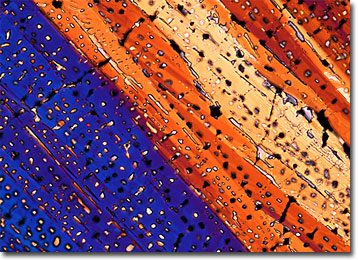Polarized Light Microscopy Digital Image Gallery
DCPA (Dimethyl Tetrachloroterephthalate)
Dimethyl Tetrachloroterephthalate, better known as DCPA, is a pesticide approved in the United States for general use. The chemical compound is commonly utilized to control annual grasses and broadleaf weeds in commercial crops as well as in many home gardens.

Also commonly known as chlorthal or chlorthal-dimethyl, DCPA has little effect on mature weeds or crops, but is instead effective at controlling plants that are in their seed and pre-emergence stages. The mechanism of action of DCPA is antagonism of auxin, a plant growth hormone that affects cell elongation, root formation, and bud development. The pesticide may be purchased in several different forms and is often sold under the trade names Dacthal and Dacthalor. Considered a class IV toxin by the Environmental Protection Agency (EPA), DCPA poses little health hazard to those who utilize the compound or accidentally come into contact with it. Indeed the greatest hazard in use of DCPA, which is not teratogenic, mutagenic, or carcinogenic, is often considered the possible presence of more dangerous impurities, such as dioxin or hexachlorobenzene, in preparations of the pesticide.
Although DCPA has a very low toxicity to humans and other mammals, the compound is moderately toxic to some birds, especially young wildfowl, and slightly toxic to certain species of fish, such as rainbow trout. In water, the degradation of DCPA is chiefly due to the action of sunlight. A metabolite of the pesticide known as tetrachloro-terephthalic acid (TTA) or diacid exhibits a much greater solubility in water than its parent compound and may leach in some kinds of soil. In fact, the metabolite has been detected in groundwater supplies in the United States and, along with other DCPA degradates, gained notoriety as the most commonly detected pesticide residues in an EPA survey of drinking water wells conducted from 1988 to 1990.
